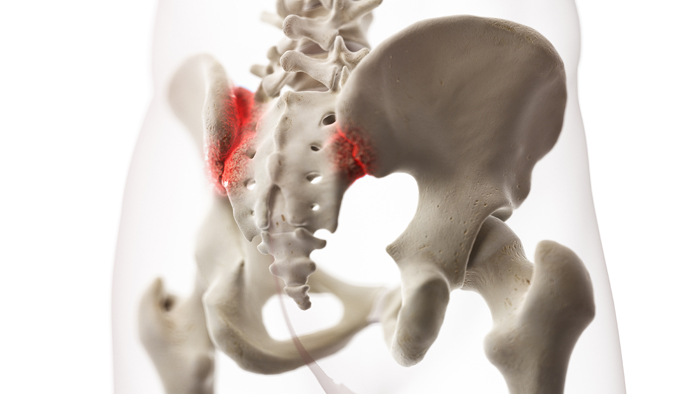Sacroiliac Joint Pain Treatment in Koramangala, Bangalore
Sacroiliac joint pain is a term for an excruciating pain in the lower back, originating in the hips and the pelvic area. It can lead to painful episodes in the thighs and legs. This is one of the most common joint pains in adults.
To know more, you can search for a sacroiliac joint pain specialist near me. You can also visit a sacroiliac joint pain hospital in Bangalore.

What do we need to know about sacroiliac joint pain?
Your sacroiliac joints are the junction between two bones - sacrum and ilium. The sacrum is a triangular-shaped bone at the bottom of the spine just above the tailbone or coccyx. Ilium is in your hip bone along with two others in the pelvis. Your sacroiliac joint acts as a support for the body and prevents any pressure or shock across the spine.
Sacroiliac joint pain affects normal activities like sitting and standing. Consult a sacroiliac joint pain specialist near you if you experience recurring pain in your lower back.
What are the symptoms of sacroiliac joint pain?
These include:
- Pain while standing up or sitting down
- Stabbing pain in the back leading to thighs, buttocks, groin and legs
- Stiffness in the pelvis
- Sore muscles due to recurring pain
- Burning sensation in the pelvis
- Feeling of numbness in the lower part of your body
- Weakness
- Inability to support your body weight
What are the causes of sacroiliac joint pain?
These are some of the common causes:
- Injury due to an accident
- Osteoarthritis leading to inflammation in the sacroiliac joint
- Ankylosing spondylitis
- Gout
- Pregnancy causes loosening of joints to accommodate the added weight leading to swelling and pain in the joints
- Infection
- Uneven strides while walking
- Improper posture
When do we need to see a doctor?
If your pain does not subside within a few days, immediately contact a sacroiliac joint pain specialist and get yourself checked. The doctor will suggest some therapies or medications and in case none of them works, surgery is recommended.
You can request an appointment at Apollo Spectra Hospitals, Koramangala, Bangalore.
Call 1860 500 2244 to book an appointment.
What are the risk factors for sacroiliac joint pain?
- Weak muscles
- Improper lifting of objects
- Inflammation in the joints
- Pregnancy or recent childbirth
- Sports or heavy exercises
How is sacroiliac joint pain diagnosed?
Diagnosing sacroiliac joint pain is difficult because of its location in the lower back region. The sacroiliac joint is situated deep in the body and it is not even clearly visible when you go for an imaging test. Your sacroiliac joint pain specialist will ask you a few questions about the symptoms and tell you to stretch your body. The doctor will be able to determine the location of your pain and prescribe treatments. Furthermore, the doctor can also inject a numbing injection in the joint like lidocaine. If the pain seems to be gone, then your doctor can confirm the issue.
How is sacroiliac joint pain treated?
- Over-the-counter pain medicines
- Prescribed drugs like
- Non-steroidal anti-Inflammatory drugs such as aspirin, ibuprofen,
- Tumor necrosis factor inhibitors to treat ankylosing spondylitis
- Oral steroids
- Muscle relaxants
- Corticosteroid injections
- Radiofrequency ablation to treat the nerves causing pain
- Surgery
- Physical therapy like massage, heat and cold treatment
- Chiropractic therapy
- Exercises and yoga
Conclusion
While some conditions can be treated with physical treatment, chiropractic treatment, injections or exercise, other serious cases are resolved only through surgical treatments. The exact cause of the pain is unknown but many factors are known to increase the chances of the pain like uneven strides while walking, heavy exercise, accidents or pregnancy-induced joint accommodation. Maintaining a good posture, exercises and yoga will help you prevent the disease.
Sacroiliac joint pain can cause chronic pain in the spinal cord, lower thighs, and legs. It also causes weak legs that cannot support the weight of the body.
X-rays, MRIs and CT scans can be used, but in most cases, these imaging tests are found to be unsuccessful in diagnosing the pain because of the joint’s difficult location.
It can affect people of all age groups. Consult a sacroiliac joint pain specialist to understand more about the disorder.
Symptoms
Our Doctors
DR. MURALIDHAR T S
MBBS, MD (Anaesthesi...
| Experience | : | 25 Yeras Experience |
|---|---|---|
| Speciality | : | Pain Management... | Location | : | Koramangala |
| Timings | : | Available by prior a... |
DR. SHRUTI BACHALLI
MBBS, MD (Anaesthesi...
| Experience | : | 16 Yeras Experience |
|---|---|---|
| Speciality | : | Pain Management... | Location | : | Koramangala |
| Timings | : | Available by prior a... |
Our Top Specialities
NOTICE BOARD
CONTACT US
CONTACT US
 Book Appointment
Book Appointment




.svg)
.svg)
.svg)
.svg)








